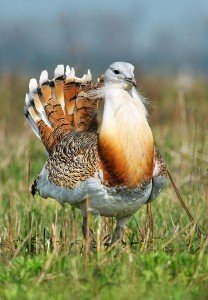The government would sell the natural wonders of Hungary
The three biggest Hungarian conservationist organizations – the Hungarian Ornithological and Nature Conservation Society (MME), the WWF Hungary, and the National Society of Conservationists-Friends of the Earth Hungary (MTVSZ) – demand that Sándor Fazekas, minister of agriculture, should refuse to allow the selling of the Natura 2000 area, which is the natural habitat of bustards, writes nol.hu.
The government is planning to sell lands in such areas as Little Cumania (Kiskunság), the Little Hungarian Plain (Kisalföld), and the Hevesi plain (Hevesi-sík), which are natural habitats of bustards; this bird is among the most endangered species in Europe. Only a couple of thousands of bustards are living within the borders of the EU, and 1400-1500 of them reside in Hungary, making it the biggest population in Central Europe. In spite of that, those lands not owned by national parks, but by the government, would be privatised in several  counties. It means only a couple of thousand acres but those lands, such as in upper Little Cumania (felső-kiskunsági), are central for the species to survive; it’s a crucial mating area with contiguous lawn and field, and the only space where there is a chance for the growth of the bustard population.
counties. It means only a couple of thousand acres but those lands, such as in upper Little Cumania (felső-kiskunsági), are central for the species to survive; it’s a crucial mating area with contiguous lawn and field, and the only space where there is a chance for the growth of the bustard population.
The organizations gave way to their concerns in connection with the selling of the Natura 2000 area several times before, and they even had part in the procedure which made it unconstitutional to sell lands which belong to national parks.
According to Attila Králl, a Hungarian Ornithological and Nature Conservation Society (MME) expert, the problem of unconstitutionality still exists: while the mentioned lands belong to the state, it has the right to make regulations for the tenants regarding the reproduction and alimentation of the bustards, and has the right to terminate the contract if the tenant violates the terms. However, if the land is in private hands, the government cannot interfere to such a great extent.
The bustard is the biggest bird in Europe which is able to fly, but only Spain, Hungary, and Russia has a relatively big population of them. The Hungarian stock is interesting for two reasons: across Europe, Hungary has the biggest contiguous nesting area (with Dévaványa in the centre, around the Körös river), and Hungary also has an internationally acknowledged program which aims to make sure that the nesting areas are not disturbed, and synchronises the birds and the agricultural area, and concentrates on saving the bustards.
One bird is worth a hundred million HUF, but this isn’t the first time that the Orbán regime doesn’t care about the fate of endangered species. The Serbian-Hungarian fence destroyed the natural habitat of the blind mole rats of the species complex Nannospalax montanosyrmiensis, which is one of the rarest animals in the world.
based on an article of nol.hu
translated by Adrienn Sain
Photo: MTI
Copy editor: bm
Source: nol.hu
please make a donation here
Hot news
Top Hungary news: Olympics in Budapest, Russian gas, Hungary’s debt, new Müller store, Prince William as landlord, expensive panel flats – 18 November, 2024
Hungarian FM: Suspending EU-Israel political dialogue ‘would be mistake’
European Commission demands a further EUR 60 million from Hungary
Hungary’s MÁV group to undergo major restructuring
Russian gas supplies to Austria disrupted: Will this threaten Hungary’s gas supply?
Hungarian opposition Jobbik urges health-care finance reform






1 Comment
Sadly this sounds more like something the British Government would do. I expected more from Hungary.